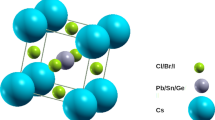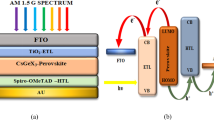Abstract
The lead (Pb)-based halide perovskites have been reported to be promising materials for photovoltaic applications; however, the presence of toxic lead in them concerns the environmental and health issues. In this work, we have, therefore, studied the lead-free and non-toxic tin-based halide perovskite, CsSnI3, which is an eco-friendly material with high power conversion efficiency, thus, being a potential candidate for photovoltaic applications. We have investigated the influence of CsI and SnI2-terminated (001) surfaces on structural, electronic and optical properties of lead-free tin-based halide perovskite CsSnI3 from the first principal calculations, based on density functional theory (DFT). The calculations of electronic and optical parameters are performed under the parameterisation of PBE_Sol for exchange–correlation functions conjugated with modified- Beche-Johnshon (mBJ) exchange potential. The optimised lattice constant, the energy band structure and the density of states (DOS) have been calculated for the bulk and different terminated surface structures. The optical properties of CsSnI3 are computed in terms of the real and imaginary part of absorption coefficient, dielectric function, refractive index, conductivity, reflectivity, extinction coefficient and electron energy loss. The photovoltaic characteristics for the CsI-termination are found to be better than the bulk and SnI2-terminated surfaces. This study reveals that optical and electronic properties can be tuned by selecting proper surface termination in halide perovskite CsSnI3. The CsSnI3 surfaces exhibit semiconductor behaviour with a direct energy band gap and a high value of absorption power in the ultraviolet and visible region, rendering these inorganic halide perovskite materials important for the eco-friendly and efficient optoelectronic devices.






Similar content being viewed by others
Data availability
Data will be available upon request.
References
Azmi R, Nurrosyid N, Lee S-H, Mubarok MA, Lee W, Hwang S, Yin W, Ahn TK, Kim TW, Ryu DY, Do YR, Jang S-Y (2020) Shallow and deep trap state passivation for low-temperature processed perovskite solar cells. ACS Energy Lett 5(5):1396–1403
Cao Y, Dong Wu, Zhu P, Shan D, Zeng X, Jun Xu (2020) Down-shifting and anti-reflection effect of CsPbBr3 quantum dots/multicrystalline silicon hybrid structures for enhanced photovoltaic properties. Nanomaterials 10(4):775
Di Liberto G, Fatale O, Pacchioni G (2021) Role of surface termination and quantum size in a-CsPbX3 (X = Cl, Br, I) 2D nanostructures for solar light harvesting. Phys Chem Chem Phys 23:3031–3040
Dong Q, Liu F, Wong MK, Tam HW, DjurišićAB NA, Surya C, Chan WK, Ng AMC (2016) Encapsulation of perovskite solar cells for high humidity conditions. Chem Sus Chem 9:2597–2603
Fu S, Zhang W, Li X, Guan J, Song W, Fang J (2021) Humidity-assisted chlorination with solid protection strategy for efficient air-fabricated inverted CsPbI3 perovskite solar cells. ACS Energy Lett 6(10):3661–3668
Hailegnaw B, Kirmayer S, Edri E, Hodes G, Cahen D (2015) Rain on methylammonium lead iodide based perovskites: possible environmental effects of perovskite solar cells. J Phys Chem Lett 6:1543–1547
Jacobsson TJ, Pazoki M, Hagfeldt A, Edvinsson T (2015) Goldschmidt’s rules and strontium replacement in lead halogen perovskite solar cells: theory and preliminary experiments on CH3NH3SrI3. J Phys Chem C 119:25673–25683
Ju MG, Dai J, Ma L, Zeng XC (2017) Perovskite chalcogenides with optimal bandgap and desired optical absorption for photovoltaic devices. Adv Energy Mater 7(18):1700216
Kamat PV, Bisquert J, Buriak J (2017) Lead-free perovskite solar cells. ACS Energy Lett 2:904–905
Keil P, Frömling T, Klein A, Jürgen R, Novak N (2017) Piezotronic effect at Schottky barrier of a metal-ZnO single crystal interface. J. Appl. Phys. 121:155701
Kim HS, Seo JY, Park NG (2016) Material and device stability in perovskite solar cells. Chem Sus Chem 9:2528–2540
Kim JY, Lee J-W, Jung HS, Shin H, Park N-G (2020) High-efficiency perovskite solar cells. Chem Rev 120(15):7867–7918
Lehner AJ, Fabini DH, Evans HA, Hébert C-A, Smock SR, Hu J, Wang H, Zwanziger JW, Chabinyc ML, Seshadri R (2015) Crystal and electronic structures of complex bismuth iodides A3Bi2I9 (A = K, Rb, Cs) related to perovskite: aiding the rational design of photovoltaics. Chem Mater 27:7137–7148
Li T, Pan Y, Wang Ze, Xia Y, Chen Y, Huang W (2017) Additive engineering for highly efficient organic–inorganic halide perovskite solar cells: recent advances and perspectives. J Mater Chem A 5:12602–12652
Lin S, Zhang B, Lü T-Y, Zheng J-C, Pan H, Chen H, Lin C, Li X, Zhou J (2021) Inorganic lead-free B-γ-CsSnI3 perovskite solar cells using diverse electron-transporting materials: a simulation study. ACS Omega 6(40):26689–26698
Liu H, Zhang H (2020) Structural, electronic and optical properties of CsMI3 (M=Ge, Sn, Pb) perovskite from first principles. American Sci Res J Eng Technol Sci 71(1):87–98
Liu B, Wu LJ, Zhao YQ, Wang LZ, Cai MQ (2016) First-principle investigations of structural, electronic, magnetic and optical properties of bulk BiVO3. RSC Adv 6:92473–92478
Raghvendra S, Kumar RR, Pandey SK (2021) Theoretical study of charge carrier lifetime and recombination on the performance of eco-friendly perovskite solar cell. IEEE Trans Electron Devices 68(7):3446–3452
Shubham B, Shukla R, Pathak C, Pandey SK (2021) Evaluation of performance constraints and structural optimization of a core-shell ZnO nanorod based eco-friendly perovskite solar cell. Sol Energy 215:473–481
Soufiani AM, Hameiri Z, Meyer S, Lim S, Taebjee MJY, Yun JS, Hobaillie A, Conibeer GJ, Spiccia L, Green MA (2016) Lessons learnt from spatially resolved electro and photoluminescence imaging: interfacial delamination in CH3NH3PbI3 planar perovskite solar cells upon illumination. Adv Energy Mater 7(9):1602111
Sun P-P, Li Q-S, Yang L-N, Li Z-S (2016a) Theoretical insights into a potential lead-free hybrid perovskite: substituting Pb2+ with Ge2+. Nanoscale 8:1503–1512
Sun S, Tominaka S, Lee J-H, Xie F, Bristowe PD, Cheetham AK (2016b) Synthesis, crystal structure, and properties of a perovskite-related bismuth phase, (NH4)3Bi2I9. APL Mater 4:031101
Traoré B, Bouder G, Lafargue-Dit-Hauret W, Rocquefelte X, Katan C, Kepenekian M, Tran F (2019) Efficient and accurate calculation of band gaps of halide perovskites with the Tran-Blaha modified Becke-Johnson potential. Phys Rev B 99(3):035139
Uribe JI, Ramirez D, Osorio-Guillén JM, Osorio J, Jaramillo F (2016) CH3NH3CaI3 perovskite: synthesis, characterization, and first-principles studies. J Phys Chem C 120:16393–16398
Wang M, Wang W, Ma B, Shen W, Liu L, Cao K, Chen S, Huang W (2012) Lead free perovskite materials for solar cells. Nano-Micro Lett 13:62
Wang Ze, Shi Z, Li T, Chen Y, Huang W (2017) Stability of perovskite solar cells: a prospective on the substitution of the A cation and X anion. Angew Chem Int Ed 56:1190–1212
Wang Y, Lee J, Hou X, Labanti C, Yan J, Mazzolini E, Parhar A, Nelson J, Kim J-S, Li Z (2021) Recent progress and challenges toward highly stable nonfullerene acceptor-based organic solar cells. Adv Energy Mater 11:52003002
Wang B, Wang H, Sathiyan G, Chen C, Yan Xu, Cheng M (2022a) Constructing efficient hole-transporting materials by tuning fluorine substitution for inverted perovskite solar cells with efficiency exceeding 20%. ACS Appl Energy Mater 5(5):5901–5908
Wang G, Chang J, Bi J, Lei M, Wang C, Qiao Q (2022b) Inorganic CsSnI3 perovskite solar cells: the progress and future prospects. Solar RRL 6(4):2100841
Wu J, Yuan S, Zhu D, Li Y, Wang HY, Dong H, Qin Y, Wang Y, Ai XC (2022) Silicon dioxide nanoparticles increase the incidence depth of short-wavelength light in active layer for high-performance perovskite solar cells. J Phys Chem C 126(17):7400–7409
Xiao Z, Meng W, Wang J, Mitzi DB, Yan Y (2017) Searching for promising new perovskite-based photovoltaic absorbers: the importance of electronic dimensionality. Mater Horiz 4:206–216
Xu L, Feng X, Jia W, Lv W, Mei A, Zhou Y, Zhang Q, Chen R, Huang W (2021) Recent advances and challenges of inverted lead-free tin-based perovskite solar cells. Energy Environ Sci 14:4292–4317
Yang S, Weifei Fu, Zhang Z, Chen H, Li C-Z (2017) Recent advances in perovskite solar cells: efficiency, stability and lead-free perovskite. J Mater Chem A 5:11462
Yu ZL, Ma Q-R, Zhao Y-Q, Liu B, Cai M-Q (2018) The surface termination -a key factor to influence electronic and optical properties of CsSnI3. J Phys Chem C 122(17):9275–9282
Yua S, Qiana F, Huab M, Gea Z, Feng J, Chong X (2022) Enhanced thermoelectric performance in inorganic CsSnI3 perovskite by doping with PbI2. Mater Lett 308A:131127
Zarenezhad H, Balkan T, Solati N, Halali M, Askari M, Kaya S (2020) Efficient carrier utilization induced by conductive polypyrrole additives in organic-inorganic halide perovskite solar cells. Sol Energy 207:1300–1307
Zhao X-G, Dalpian GM, Wang Z, Zunger A (2020) Polymorphous nature of cubic halide perovskites. Phy Rev B 101:155137
Zhou H, Chen Q, Li G, Luo S, Song TB, Duan HS, Hong Z, You J, Liu Y, Yang Y (2014) Interface engineering of highly efficient perovskite solar cells. Science 345:542–546
Funding
This work is funded by Project No. 6 under RUSA 2.0 Programme, sanctioned to Department of Physics, University of Rajasthan, Jaipur, India.
Author information
Authors and Affiliations
Contributions
All authors contributed to the study in the design and theoretical calculations. The data were analysed by Jagdish Nehra, Mukesh Kilak and Rishi Kumar Singhal. The first draft of the manuscript was written by Jagdish Nehra and commented, corrected by Rishi Kumar Singhal. All the authors have read and approved the final manuscript.
Corresponding author
Ethics declarations
Ethics approval
Not applicable.
Concent to participate
Not applicable.
Concent for publication
Not applicable.
Competing interests
The authors declare no competing interests.
Additional information
Responsible Editor: Philippe Garrigues
Publisher's note
Springer Nature remains neutral with regard to jurisdictional claims in published maps and institutional affiliations.
Rights and permissions
Springer Nature or its licensor (e.g. a society or other partner) holds exclusive rights to this article under a publishing agreement with the author(s) or other rightsholder(s); author self-archiving of the accepted manuscript version of this article is solely governed by the terms of such publishing agreement and applicable law.
About this article
Cite this article
Nehra, J., Kilak, M. & Singhal, R.K. Effect of surface termination on electronic and optical properties of lead-free tin-based eco-friendly perovskite solar cell: a first principal study. Environ Sci Pollut Res 30, 98796–98804 (2023). https://doi.org/10.1007/s11356-023-26890-w
Received:
Accepted:
Published:
Issue Date:
DOI: https://doi.org/10.1007/s11356-023-26890-w




